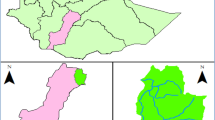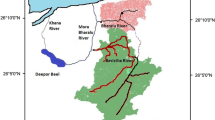Abstract
Assessment of future water availability is a challenging task under changing climatic conditions and anthropogenic interventions. The current research focuses on future water resources scenario generation for contributing areas of proposed hydraulic structures generated from the Water Evaluation and Planning (WEAP) System model. The proposed methodology was implemented for the Dwarakeswar-Gandherswari river basin (India) which needs a long-term future water use plan. Bias-corrected Representative Concentration Pathways (RCPs) data were used for climate change analysis through a hydrological model. Different simulation model outputs [e.g. Dynamic Conversion of Land-Use and its Effects (Dyna-CLUE), Soil and Water Assessment Tool (SWAT), Modular Finite-Difference Flow Model (MODFLOW)] were utilized in water evaluation model for a generation of future water resources scenarios. Four scenarios (2010–2030–2050-2080) were generated for the sustainability of limited water resources management strategies. SWAT simulated results show an increase in river discharge for 2030 or 2080 and a decrease for 2050. MODFLOW simulated results show a visible groundwater storage change for 2030 but minimal change for 2050 and 2080 scenarios. The results also show a decrease in agricultural land and an increase in population for the contributing areas of three hydraulic structures during 2010–2030–2050-2080. These results provide a piece of valuable information for decision-makers in future water management plan preparation.




Similar content being viewed by others
References
Ahn JM, Lyu S (2017) Assessing Future River Environments in the Seomjin River Basin due to Climate Change. Journal of Environmental Engineering 143(5):04017005
Aljerf L (2018) Data of thematic analysis of farmer′ s use behavior of recycled industrial wastewater. Data in Brief 21:240–250
Arnold JG, Moriasi DN, Gassman PW, Abbaspour KC, White MJ, Srinivasan R, Kannan N (2012) SWAT: model use, calibration, and validation. Trans ASABE 55(4):1491–1508
Anand J, Gosain AK, Khosa R, Srinivasan R (2018) Regional scale hydrologic modeling for prediction of water balance, analysis of trends in streamflow and variations in streamflow: The case study of the Ganga River basin. Journal of Hydrology Regional Studies 16:32–53
Clarke L, Edmonds J, Jacoby H, Pitcher H, Reilly J, Richels R (2007) Scenarios of greenhouse gas emissions and atmospheric concentrations. Sub-report 2.1A of synthesis and assessment product 2.1 by the U.S. climate change science program and the subcommittee on global change research. Department of Energy, Office of Biological & environmental research, Washington, 7 DC., USA, 154 pp.
Carvalho-Santos C, Monteiro AT, Azevedo JC, Honrado JP, Nunes JP (2017) Climate change impacts on water resources and reservoir management: uncertainty and adaptation for a mountain catchment in Northeast Portugal. Water Resour Manag 31:3355–3370
Chen M, Izady A, Abdalla OA (2017) An efficient surrogate-based simulation-optimization method for calibrating a regional MODFLOW model. J Hydrol 544:591–603
Chakrabortty R, Pal SC, Chowdhuri I, Malik S, Das B (2020) Assessing the importance of static and dynamic causative factors on Erosion potentiality using SWAT, EBF with uncertainty and plausibility, Logistic Regression and Novel Ensemble Model in a Sub-Tropical Environment Journal of the Indian Society of Remote Sensing, 1–25
Dhar S, Mazumdar A (2009) Hydrological modelling of the Kangsabati River under changed climate scenario: case study in India. Hydrological Processes: An International Journal 23(16):2394–2406
Fang GH, Yang J, Chen YN, Zammit C (2015) Comparing bias correction methods in downscaling meteorological variables for a hydrologic impact study in an arid area in China. Hydrol Earth Syst Sci 19(6):2547–2559
Gao J, Christensen P, Li W (2017) Application of the WEAP model in strategic environmental assessment: experiences from a case study in an arid/semi-arid area in China. J Environ Manag 198:363–371
Garg V, Nikam BR, Thakur PK, Aggarwal SP, Gupta PK, Srivastav SK (2019) Human-induced land use land cover change and its impact on hydrology. HydroResearch 1:48–56
Gedefaw M, Wang H, Yan D, Qin T, Wang K, Girma A, Abiyu A (2019) Water resources allocation systems under irrigation expansion and climate change scenario in Awash River basin of Ethiopia. Water 11(10):1966
Gomo M (2019) On the interpretation of multi-well aquifer-pumping tests in confined porous aquifers using the Cooper and Jacob (1946) method. Sustainable Water Resources Management 5:935–946
Jingli SO, Ling LI, Yali CUI, Zhaoji Z (2013) Groundwater flow simulation and its application in groundwater resource evaluation in the North China plain, China. Acta Geologica Sinica-English Edition 87(1):243–253
Jung CG, Lee DR, Moon JW (2016) Comparison of the Penman-Monteith method and regional calibration of the Hargreaves equation for actual evapotranspiration using SWAT-simulated results in the Seolma-cheon basin, South Korea. Hydrol Sci J 61:793–800
Kourgialas NN, Koubouris GC, Dokou Z (2019) Optimal irrigation planning for addressing current or future water scarcity in Mediterranean tree crops. Sci Total Environ 654:616–632
Lévite H, Sally H, Cour J (2003) Testing water demand management scenarios in a water-stressed basin in South Africa: application of the WEAP model. Physics and Chemistry of the Earth, Parts A/B/C 28(20–27):779–786
Liu C, Zhang Z, Balay JW (2018b) Posterior assessment of reference gages for water resources management using instantaneous flow measurements. Sci Total Environ 634:12–19
Liu L, Parkinson S, Gidden M, Byers E, Sato Y, Riahi K, Forman B (2018a) Quantifying the potential for reservoirs to secure future surface water yields in the world’s largest river basins. Environ Res Lett 13(4):044026
Luo M, Liu T, Meng F, Duan Y, Frankl A, Bao A, De Maeyer P (2018) Comparing bias correction methods used in downscaling precipitation and temperature from regional climate models: a case study from the Kaidu River basin in Western China. Water 10(8):1046
Maliehe M, Mulungu DM (2017) Assessment of water availability for competing uses using SWAT and WEAP in south Phuthiatsana catchment, Lesotho. Physics and Chemistry of the Earth Parts A/B/C 100:305–316
Mani A, Tsai FTC, Kao SC, Naz BS, Ashfaq M, Rastogi D (2016) Conjunctive management of surface and groundwater resources under projected future climate change scenarios. J Hydrol 540:397–411
Maheswaran R, Khosa R, Gosain AK, Lahari S, Sinha SK, Chahar BR, Dhanya CT (2016) Regional scale groundwater modelling study for Ganga River basin. J Hydrol 541:727–741
McDonald MG, Harbaugh AW (1988) A modular three-dimensional finite-difference ground-water flow model. US Geological Survey
Niswonger RG (2020) An agricultural water use package for MODFLOW and GSFLOW. Environ Model Softw, 104617
Raju KS, Sonali P, Kumar DN (2017) Ranking of CMIP5-based global climate models for India using compromise programming. Theor Appl Climatol 128(3–4):563–574
Roy D, Banerjee D (2010) Performance analysis of the proposed reservoir project in the state of West Bengal. Hydrology & Earth System Sciences Discussions 7(1):1373–1405
Shrestha M, Acharya SC, Shrestha PK (2017) Bias correction of climate models for hydrological modelling–are simple methods still useful? Meteorol Appl 24(3):531–539
Smitha PS, Narasimhan B, Sudheer KP, Annamalai H (2018) An improved bias correction method of daily rainfall data using a sliding window technique for climate change impact assessment. J Hydrol 556:100–118
Sahoo S, Dhar A, Debsarka A, Kar A (2018a) Impact of water demand on hydrological regime under climate and LULC change scenarios. Environ Earth Sci 77(9):341
Sahoo S, Sil I, Dhar A, Debsarkar A, Das P, Kar A (2018b) Future scenarios of land-use suitability modeling for agricultural sustainability in a river basin. J Clean Prod 205:313–328
Sahoo S, Dey S, Dhar A, Debsarkar A, Pradhan B (2019) On projected hydrological scenarios under the influence of bias-corrected climatic variables and LULC. Ecol Indic 106:105440
Sabzzadeh I, Shourian M (2020) Maximizing crops yield net benefit in a groundwater-irrigated plain constrained to aquifer stable depletion using a coupled PSO-SWAT-MODFLOW hydro-agronomic model Journal of Cleaner Production, 121349
Tizora P, Le Roux A, Mans G, Cooper AK (2018) Adapting the Dyna-CLUE model for simulating land use and land cover change in the Western Cape Province. South African Journal of Geomatics 7(2):190–203
Tena TM, Mwaanga P, Nguvulu A (2019) Hydrological Modelling and water resources assessment of Chongwe River catchment using WEAP model. Water 11(4):839
Wang J, Hou B, Jiang D, Xiao W, Wu Y, Zhao Y, Wang G (2016) Optimal allocation of water resources based on water supply security. Water 8(6):237
Willet J, King J, Wetser K, Dykstra JE, Essink GO, Rijnaarts HH (2020) Water supply network model for sustainable industrial resource use a case study of Zeeuws-Vlaanderen in the Netherlands. Water Resources and Industry, 100131
Verburg PH, Soepboer W, Veldkamp A, Limpiada R, Espaldon V, Mastura SS (2002) Modeling the spatial dynamics of regional land use: the CLUE-S model. Environ Manag 30(3):391–405
Vissa NK, Anandh PC, Behera MM, Mishra S (2019) ENSO-induced groundwater changes in India derived from GRACE and GLDAS. Journal of Earth System Science 128(5):115
Xiang Z, Bailey RT, Nozari S, Husain Z, Kisekka I, Sharda V, Gowda P (2020) DSSAT-MODFLOW: a new modeling framework for exploring groundwater conservation strategies in irrigated areas. Agric Water Manag 232:106033
Yan R, Cai Y, Li C, Wang X, Liu Q (2019) Hydrological responses to climate and land use changes in a watershed of the loess plateau, China. Sustainability 11(5):1443
Yaykiran S, Cuceloglu G, Ekdal A (2019) Estimation of water budget components of the Sakarya River basin by using the WEAP-PGM model. Water 11(2):271
Zhou Y, Li W (2011) A review of regional groundwater flow modeling. Geosci Front 2(2):205–214
Zhang X (2015) Conjunctive surface water and groundwater management under climate change. Frontiers in Environmental Science 3:59
Acknowledgments
The author thanks Irrigation and Waterways Directorate, Government of West Bengal, India for providing necessary support for this research work. The author also thanks Regional Director, Central Ground Water Board (CGWB) for providing necessary data for this research work.
Funding
This paper is supported by the Centre for Advanced Modelling and Geospatial Information Systems, UTS and Researchers Supporting Project number RSP-2020/14, King Saud University, Riyadh, Saudi Arabia.
Author information
Authors and Affiliations
Corresponding author
Ethics declarations
Conflict of Interest
The authors declare no conflict of interest.
Additional information
Publisher’s Note
Springer Nature remains neutral with regard to jurisdictional claims in published maps and institutional affiliations.
Electronic supplementary material
ESM 1
(DOCX 6495 kb)
Rights and permissions
About this article
Cite this article
Sahoo, S., Dhar, A., Debsarkar, A. et al. Future Water Use Planning by Water Evaluation and Planning System Model. Water Resour Manage 34, 4649–4664 (2020). https://doi.org/10.1007/s11269-020-02680-8
Received:
Accepted:
Published:
Issue Date:
DOI: https://doi.org/10.1007/s11269-020-02680-8




